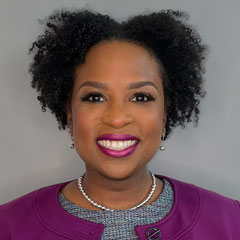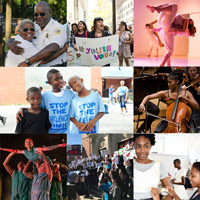In 2016, Chicago experienced a spike in gun violence the likes of which the city had not seen in decades. During that year, Chicago saw 4,368 shootings and 764 homicides. Since then, it seems that every time one opens the newspaper or turns on the television news, there has been another shooting. Another death. Another grieving mother. Another child innocently gunned down. Suddenly “The Windy City” has become known as “Chi-raq,” a seemingly lawless city with apathetic citizens who are helpless against gangs and guns.
At last week’s Promising Solutions to Reducing Gun Violence event, panelists shared a different story: one of hope, resilience, and progress. In a discussion moderated by MacArthur President Julia Stasch, community leaders shared their perspectives on successful strategies that they see working in the neighborhoods hardest hit by gun violence. Much like the AFC Theater at Target Area Development Corporation, an architectural gem designed by the firm Newhouse & Bernham where we held the conversation, these stories are often overlooked. But they are critically important in understanding the truth about Chicago, its neighborhoods, and its people.
The location for this conversation, in the Auburn Gresham neighborhood on the South Side of Chicago, is critically important—not just because it took place outside of the Loop, Chicago’s central business district, but because it underscored that there is beauty in the places that are often written off as violent. Sometimes the pathway to change is simply opening our eyes and stretching beyond our comfort zone to build a bridge to those who are different or who have a different set of experiences.
Jorge Matos, the Director of the Safe Streets program at the Alliance of Local Service Organizations, kicked off the conversation discussing the importance of building relationships. In his role as a street outreach worker with individuals who are at risk of shooting or being shot, he attempts to build bridges with program participants by first acknowledging that he was once where they are. He understands the challenges that they face, but he also made the choice to change. And now he models the behavior that he wants to see changed in others.
Tanya Woods, Executive Director at the West Side Justice Center, underscored the importance of building relationships from a service delivery perspective. While her life trajectory and current circumstances may appear different from many of the residents she serves, Woods grew up on the West Side and is intimately familiar with the needs of the community. Her lived experience and deep knowledge of the neighborhood helped her build relationships with her clients and, ultimately, earn their trust, thus enabling her to more effectively deliver the services that they most want and need.
Teny Gross, Executive Director of the Institute for Nonviolence Chicago, reminded us that it is not just the relationship between service providers and people affected by gun violence that is important. We must also build trust between outreach organizations and the police department, and between police officers and communities they serve. For communities of color, relationships with law enforcement have been fraught for centuries. We must acknowledge the impossible demands and enormous pressures that the police face, while helping them to recognize the humanity in individuals and communities experiencing violence. This can assist officers in understanding the tremendous trauma that residents have endured.
William “Billy” Moore, a case manager at the Inner-City Muslim Action Network, believes that having a trauma-informed approach to the work is an essential ingredient of helping to divert individuals from a life of crime. He reminded the audience that “Hurt people, hurt people. So we have to become more trauma-informed, so we can start teaching healed people to heal people.” Billy pointed out that often what manifests as gun violence began as childhood trauma, such as witnessing violence at an early age—something that Matos also underscored. Recognizing the signs of trauma and appropriately addressing mental health will go a long way towards preventing future incidents of violence.
Some may question these approaches to reduce gun violence in Chicago: Building relationships. Establishing trust. Meeting people where they are. Acknowledging and repairing harm.
In fact, this approach to street outreach and violence interruption in Chicago was modeled on effective strategies from cities that have seen drastic reductions in violence such as Boston, Los Angeles, and Providence. And Chicago is beginning to see results. Statistics point to a 47 percent reduction in violent incidents in the Austin neighborhood since the Institute for Nonviolence Chicago began its work there in 2016. And, in the two years that Communities Partnering 4 Peace has been in operation, there has been a 25 percent decrease in shootings in seven of the nine target neighborhoods in which it works. Homicides are down 33 percent in eight of the targeted neighborhoods.
MacArthur, in cooperation with more than 40 local funders, has supported these and other violence prevention efforts through the Partnership for Safe and Peaceful Communities. The goal of the Partnership is to substantially reduce gun violence in Chicago, in part by intervening with likely victims and shooters through street outreach, connection to social services, cognitive behavioral therapy, job training, and employment. While we have seen some successes over the past few years, there is still much work to be done. Stasch sums it up best:
The Partnership has committed nearly $75 Million to tackling Chicago’s gun violence, but Chicago’s philanthropic community cannot do this work alone. It will take each one of us. Businesses must commit to hiring talented individuals who may have previously been involved with the criminal justice system but who have committed to making a positive change in their lives. Faith leaders must lead their congregations to reclaim their neighborhoods as safe spaces and mentor those who have gone astray. Residents must build community cohesion and crowd out violence. Government must prioritize public safety in their budgets, with a focus on those communities that need public resources most. The good news is that much of this work is already underway, but we need to amplify these stories and keep inspiring each other to build relationships and take more ownership. Gun violence is our collective issue to address. No matter our zip code. No matter our race. Together, we can stop the bleeding and reclaim our city.




